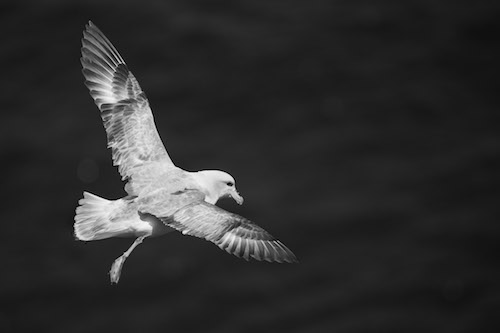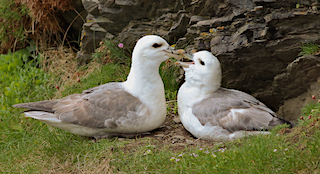 Fulmars look superficially like gulls but are, in fact, related to Albatrosses. They can be spotted near to coastal cliffs, such as at Lizard Point.
Fulmars look superficially like gulls but are, in fact, related to Albatrosses. They can be spotted near to coastal cliffs, such as at Lizard Point.
Photo: Amanda Scott
Scientific name: Fulmarus glacialis
Other common names: Northern Fulmar
Conservation status: IUCN Red List, Least Concern; UK Birds of Conservation Concern, Amber, because of a recent decline in the breeding population.
Fulmars are far more common along the coastline of Scotland and the Scottish islands (St. Kilda being one of their most famous colonies), but they can also be seen around the Cornish coast. Britain hosts some 500,000 breeding pairs in the summer, but in the winter migrants increase numbers to 1.6 to 1.8 million birds. A clifftop-breeding bird, they can be spotted at any time of year near to cliffs, gliding over the sea, their wings held stiffly flat, or soaring up the cliff face on thermal air currents.

With their pale-grey wings and white head and bodies, it is easy to confuse them with gulls, but they are in fact in the same family as petrels and shearwaters. Look for the tubular ‘nostrils’ – the tubenose – above its yellow bill as one of the most obvious identification features. This tubenose has an important function. A Fulmar’s bloodstream passes through a gland located at the front of its head, where excess salt is extracted and then secreted along the tubenose: this enables it to be channelled as a salty fluid to the end of the bill, where it drips away without soiling the bird’s feathers.
 The Fulmar is a relatively long-lived bird, with an expected lifespan of about 40 years. Individuals reach breeding maturity at about 9 years old, and, once paired, remain monogamous. They lay a single white egg, usually on grassy ledges near the clifftop. Both chicks and adults have an effective method of deterring predators: they spit a foul-smelling oily substance at anything that gets too close. This is Fulmar oil, secreted from the stomach.
The Fulmar is a relatively long-lived bird, with an expected lifespan of about 40 years. Individuals reach breeding maturity at about 9 years old, and, once paired, remain monogamous. They lay a single white egg, usually on grassy ledges near the clifftop. Both chicks and adults have an effective method of deterring predators: they spit a foul-smelling oily substance at anything that gets too close. This is Fulmar oil, secreted from the stomach.
Fulmars, once fledged, feed exclusively at sea on fish, crustaceans and fish-offal. They are vulnerable to ingesting plastic litter, which accumulates in their stomach: this may cause problems with food intake and digestion.
Did you know…?
…The genus name Fulmarus is derived from Old Norse, and literally means ‘foul gull’, a reference to the smelly stomach oil. The species name glacialis means ‘icy’.
…The distribution of Fulmars in Britain spread from St Kilda in the nineteenth and twentieth centuries, and the birds were found across the UK by the 1930s: this was at least partly in response to the increase in commercial fisheries and therefore the availability of fish offal as food. Fulmars are now however on the UK Amber list due to more recent decreases in the number of breeding pairs.
More information and references:
Gooders, J. and Harris, A., 1986. Field Guide to the Birds of Britain and Ireland. Kingfisher Books, London.
Published: February 2014 (updated February 2020)
Author: Amanda Scott
Photos: Richard Birchett: Fulmar in flight; Amanda Scott: Fulmar pair on cliff
